BTEC Level 5 HND: Unit 11 Role of Public Health in Health & Care
VerifiedAdded on 2023/06/13
|11
|3343
|300
Report
AI Summary
This report provides an overview of the role of public health in health and social care, focusing on strategies to measure, monitor, and control the incidence of disease in communities. It identifies various agencies, including the World Health Organization (WHO), the UK Department of Health, and local health trusts, and explains their roles in addressing health and disease at international, national, and local levels. The report uses statistical data to discuss the epidemiology of infectious diseases like HIV and non-infectious diseases like diabetes in the UK, evaluating the effectiveness of different approaches such as surveillance, screening, immunization, and education. Furthermore, it addresses risk factors like smoking, alcoholism, and diet, emphasizing the importance of self-management, primary and secondary prevention, and improved management of patients with both physical and mental health needs. The document also highlights the impact of lifestyle choices on health and the significance of social needs, diet, and hygiene in maintaining individual well-being.
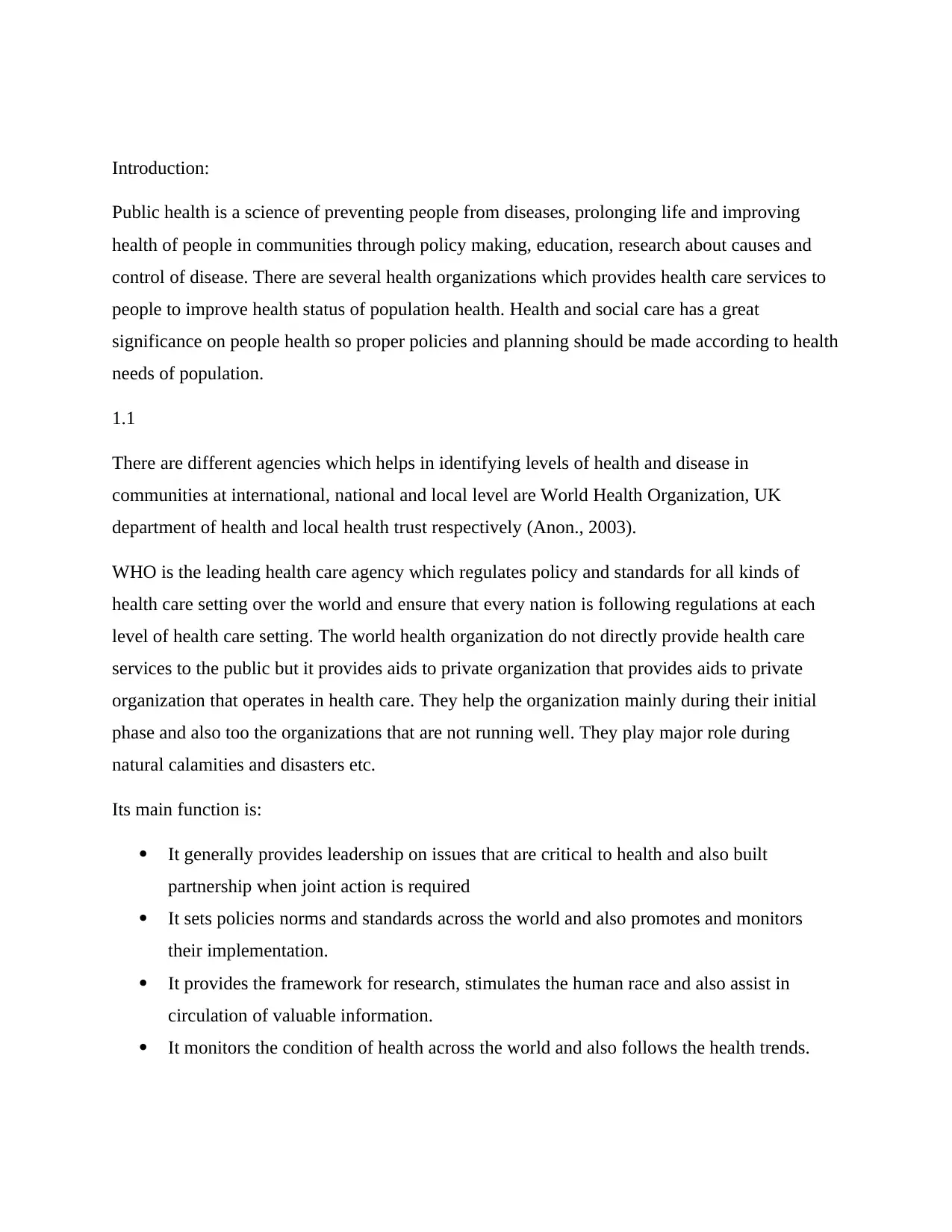
Introduction:
Public health is a science of preventing people from diseases, prolonging life and improving
health of people in communities through policy making, education, research about causes and
control of disease. There are several health organizations which provides health care services to
people to improve health status of population health. Health and social care has a great
significance on people health so proper policies and planning should be made according to health
needs of population.
1.1
There are different agencies which helps in identifying levels of health and disease in
communities at international, national and local level are World Health Organization, UK
department of health and local health trust respectively (Anon., 2003).
WHO is the leading health care agency which regulates policy and standards for all kinds of
health care setting over the world and ensure that every nation is following regulations at each
level of health care setting. The world health organization do not directly provide health care
services to the public but it provides aids to private organization that provides aids to private
organization that operates in health care. They help the organization mainly during their initial
phase and also too the organizations that are not running well. They play major role during
natural calamities and disasters etc.
Its main function is:
It generally provides leadership on issues that are critical to health and also built
partnership when joint action is required
It sets policies norms and standards across the world and also promotes and monitors
their implementation.
It provides the framework for research, stimulates the human race and also assist in
circulation of valuable information.
It monitors the condition of health across the world and also follows the health trends.
Public health is a science of preventing people from diseases, prolonging life and improving
health of people in communities through policy making, education, research about causes and
control of disease. There are several health organizations which provides health care services to
people to improve health status of population health. Health and social care has a great
significance on people health so proper policies and planning should be made according to health
needs of population.
1.1
There are different agencies which helps in identifying levels of health and disease in
communities at international, national and local level are World Health Organization, UK
department of health and local health trust respectively (Anon., 2003).
WHO is the leading health care agency which regulates policy and standards for all kinds of
health care setting over the world and ensure that every nation is following regulations at each
level of health care setting. The world health organization do not directly provide health care
services to the public but it provides aids to private organization that provides aids to private
organization that operates in health care. They help the organization mainly during their initial
phase and also too the organizations that are not running well. They play major role during
natural calamities and disasters etc.
Its main function is:
It generally provides leadership on issues that are critical to health and also built
partnership when joint action is required
It sets policies norms and standards across the world and also promotes and monitors
their implementation.
It provides the framework for research, stimulates the human race and also assist in
circulation of valuable information.
It monitors the condition of health across the world and also follows the health trends.
Paraphrase This Document
Need a fresh take? Get an instant paraphrase of this document with our AI Paraphraser
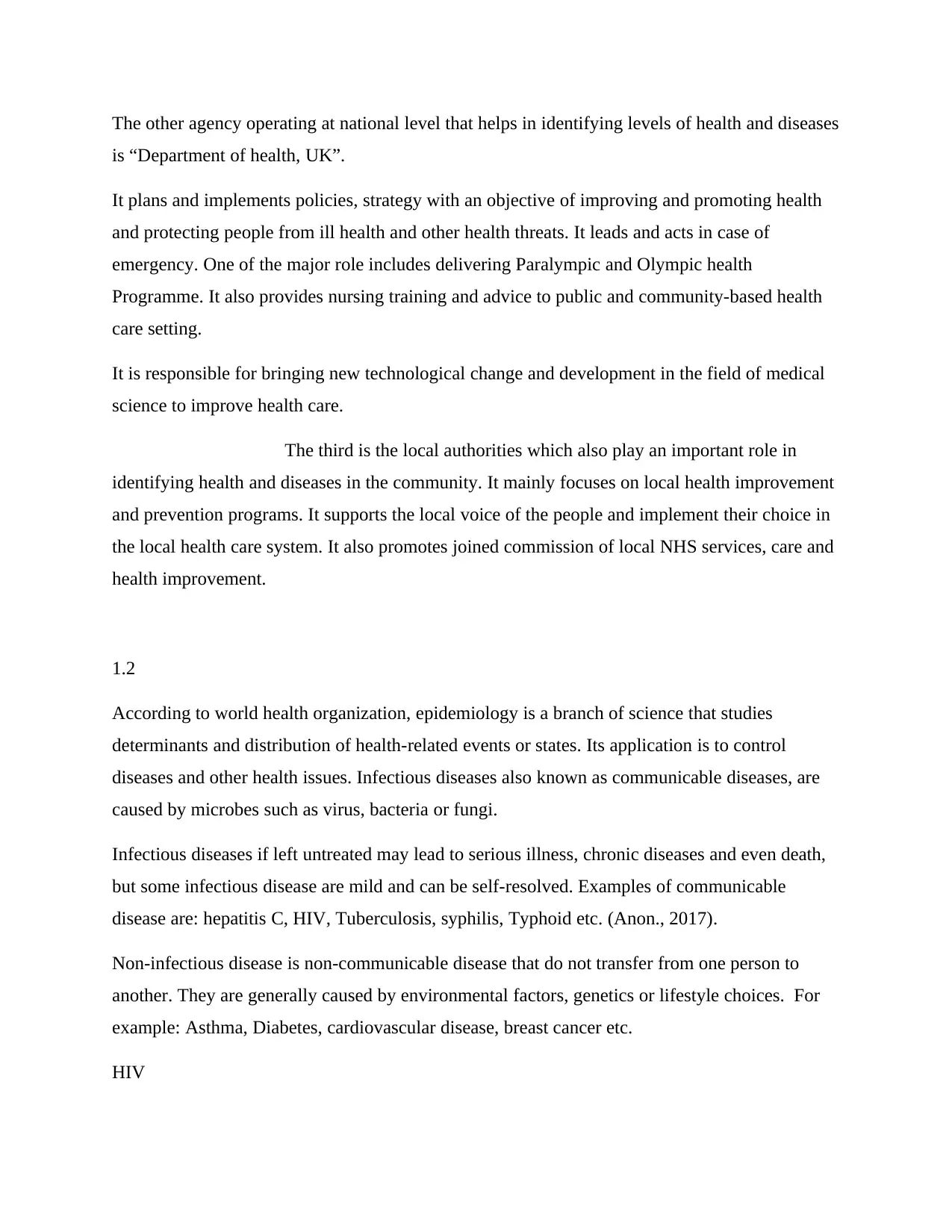
The other agency operating at national level that helps in identifying levels of health and diseases
is “Department of health, UK”.
It plans and implements policies, strategy with an objective of improving and promoting health
and protecting people from ill health and other health threats. It leads and acts in case of
emergency. One of the major role includes delivering Paralympic and Olympic health
Programme. It also provides nursing training and advice to public and community-based health
care setting.
It is responsible for bringing new technological change and development in the field of medical
science to improve health care.
The third is the local authorities which also play an important role in
identifying health and diseases in the community. It mainly focuses on local health improvement
and prevention programs. It supports the local voice of the people and implement their choice in
the local health care system. It also promotes joined commission of local NHS services, care and
health improvement.
1.2
According to world health organization, epidemiology is a branch of science that studies
determinants and distribution of health-related events or states. Its application is to control
diseases and other health issues. Infectious diseases also known as communicable diseases, are
caused by microbes such as virus, bacteria or fungi.
Infectious diseases if left untreated may lead to serious illness, chronic diseases and even death,
but some infectious disease are mild and can be self-resolved. Examples of communicable
disease are: hepatitis C, HIV, Tuberculosis, syphilis, Typhoid etc. (Anon., 2017).
Non-infectious disease is non-communicable disease that do not transfer from one person to
another. They are generally caused by environmental factors, genetics or lifestyle choices. For
example: Asthma, Diabetes, cardiovascular disease, breast cancer etc.
HIV
is “Department of health, UK”.
It plans and implements policies, strategy with an objective of improving and promoting health
and protecting people from ill health and other health threats. It leads and acts in case of
emergency. One of the major role includes delivering Paralympic and Olympic health
Programme. It also provides nursing training and advice to public and community-based health
care setting.
It is responsible for bringing new technological change and development in the field of medical
science to improve health care.
The third is the local authorities which also play an important role in
identifying health and diseases in the community. It mainly focuses on local health improvement
and prevention programs. It supports the local voice of the people and implement their choice in
the local health care system. It also promotes joined commission of local NHS services, care and
health improvement.
1.2
According to world health organization, epidemiology is a branch of science that studies
determinants and distribution of health-related events or states. Its application is to control
diseases and other health issues. Infectious diseases also known as communicable diseases, are
caused by microbes such as virus, bacteria or fungi.
Infectious diseases if left untreated may lead to serious illness, chronic diseases and even death,
but some infectious disease are mild and can be self-resolved. Examples of communicable
disease are: hepatitis C, HIV, Tuberculosis, syphilis, Typhoid etc. (Anon., 2017).
Non-infectious disease is non-communicable disease that do not transfer from one person to
another. They are generally caused by environmental factors, genetics or lifestyle choices. For
example: Asthma, Diabetes, cardiovascular disease, breast cancer etc.
HIV
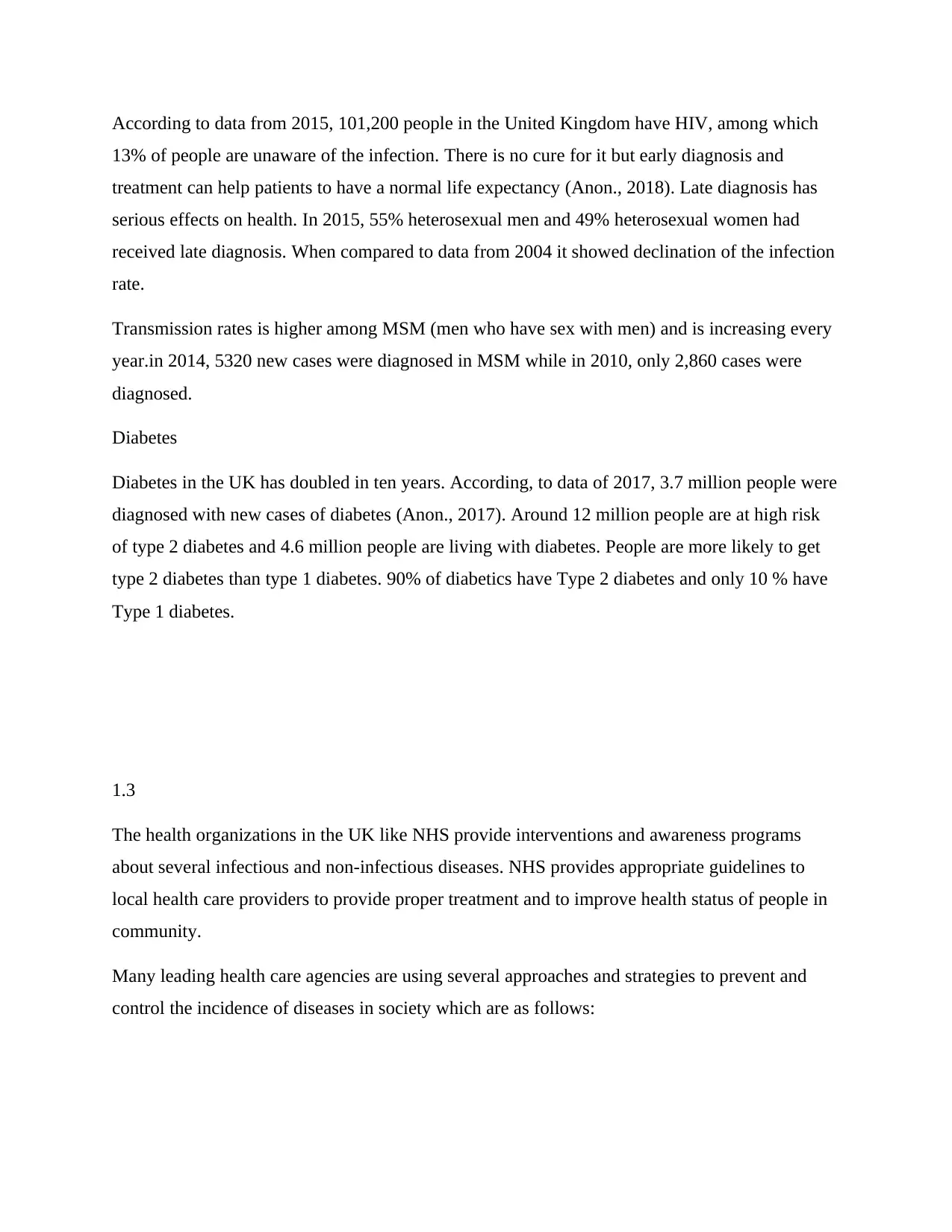
According to data from 2015, 101,200 people in the United Kingdom have HIV, among which
13% of people are unaware of the infection. There is no cure for it but early diagnosis and
treatment can help patients to have a normal life expectancy (Anon., 2018). Late diagnosis has
serious effects on health. In 2015, 55% heterosexual men and 49% heterosexual women had
received late diagnosis. When compared to data from 2004 it showed declination of the infection
rate.
Transmission rates is higher among MSM (men who have sex with men) and is increasing every
year.in 2014, 5320 new cases were diagnosed in MSM while in 2010, only 2,860 cases were
diagnosed.
Diabetes
Diabetes in the UK has doubled in ten years. According, to data of 2017, 3.7 million people were
diagnosed with new cases of diabetes (Anon., 2017). Around 12 million people are at high risk
of type 2 diabetes and 4.6 million people are living with diabetes. People are more likely to get
type 2 diabetes than type 1 diabetes. 90% of diabetics have Type 2 diabetes and only 10 % have
Type 1 diabetes.
1.3
The health organizations in the UK like NHS provide interventions and awareness programs
about several infectious and non-infectious diseases. NHS provides appropriate guidelines to
local health care providers to provide proper treatment and to improve health status of people in
community.
Many leading health care agencies are using several approaches and strategies to prevent and
control the incidence of diseases in society which are as follows:
13% of people are unaware of the infection. There is no cure for it but early diagnosis and
treatment can help patients to have a normal life expectancy (Anon., 2018). Late diagnosis has
serious effects on health. In 2015, 55% heterosexual men and 49% heterosexual women had
received late diagnosis. When compared to data from 2004 it showed declination of the infection
rate.
Transmission rates is higher among MSM (men who have sex with men) and is increasing every
year.in 2014, 5320 new cases were diagnosed in MSM while in 2010, only 2,860 cases were
diagnosed.
Diabetes
Diabetes in the UK has doubled in ten years. According, to data of 2017, 3.7 million people were
diagnosed with new cases of diabetes (Anon., 2017). Around 12 million people are at high risk
of type 2 diabetes and 4.6 million people are living with diabetes. People are more likely to get
type 2 diabetes than type 1 diabetes. 90% of diabetics have Type 2 diabetes and only 10 % have
Type 1 diabetes.
1.3
The health organizations in the UK like NHS provide interventions and awareness programs
about several infectious and non-infectious diseases. NHS provides appropriate guidelines to
local health care providers to provide proper treatment and to improve health status of people in
community.
Many leading health care agencies are using several approaches and strategies to prevent and
control the incidence of diseases in society which are as follows:
⊘ This is a preview!⊘
Do you want full access?
Subscribe today to unlock all pages.

Trusted by 1+ million students worldwide
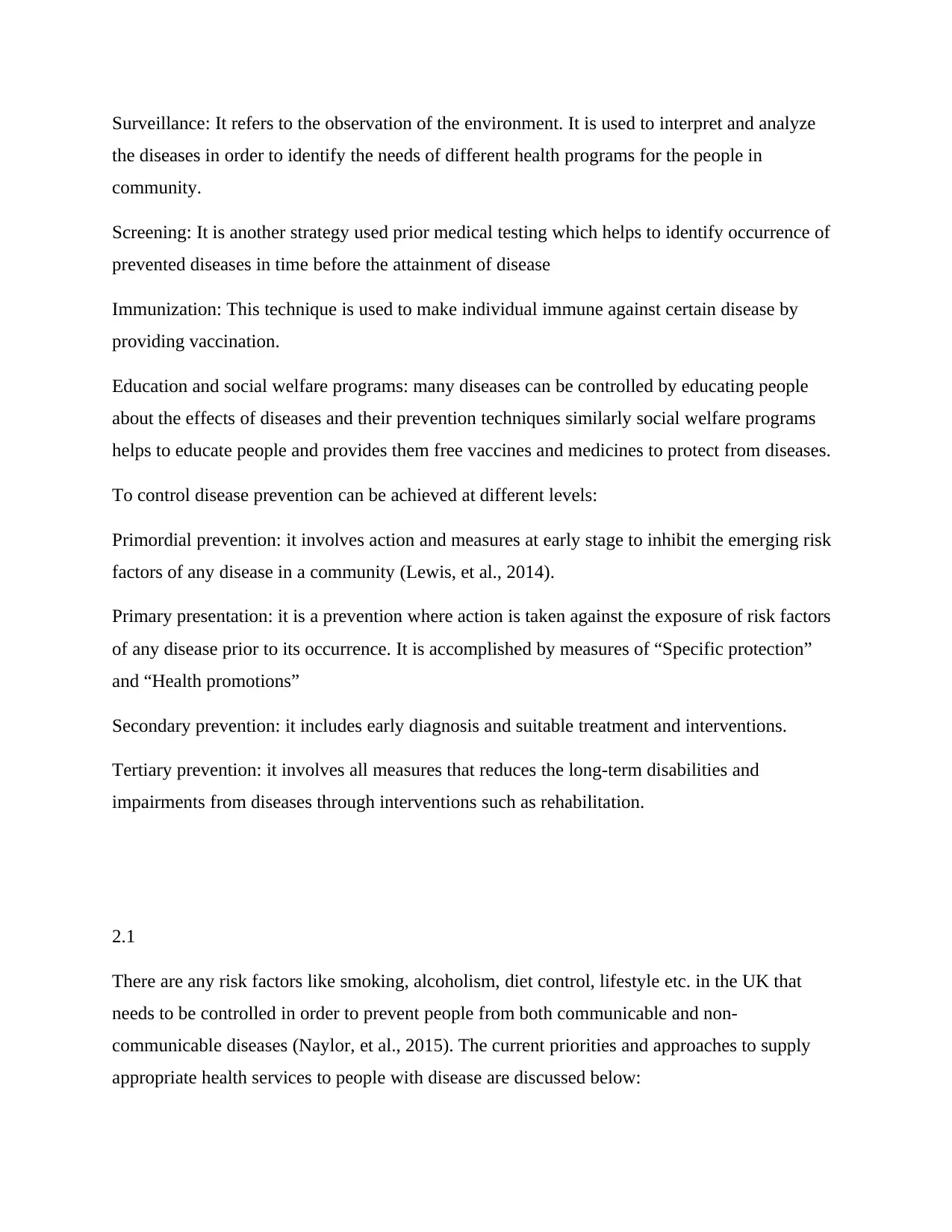
Surveillance: It refers to the observation of the environment. It is used to interpret and analyze
the diseases in order to identify the needs of different health programs for the people in
community.
Screening: It is another strategy used prior medical testing which helps to identify occurrence of
prevented diseases in time before the attainment of disease
Immunization: This technique is used to make individual immune against certain disease by
providing vaccination.
Education and social welfare programs: many diseases can be controlled by educating people
about the effects of diseases and their prevention techniques similarly social welfare programs
helps to educate people and provides them free vaccines and medicines to protect from diseases.
To control disease prevention can be achieved at different levels:
Primordial prevention: it involves action and measures at early stage to inhibit the emerging risk
factors of any disease in a community (Lewis, et al., 2014).
Primary presentation: it is a prevention where action is taken against the exposure of risk factors
of any disease prior to its occurrence. It is accomplished by measures of “Specific protection”
and “Health promotions”
Secondary prevention: it includes early diagnosis and suitable treatment and interventions.
Tertiary prevention: it involves all measures that reduces the long-term disabilities and
impairments from diseases through interventions such as rehabilitation.
2.1
There are any risk factors like smoking, alcoholism, diet control, lifestyle etc. in the UK that
needs to be controlled in order to prevent people from both communicable and non-
communicable diseases (Naylor, et al., 2015). The current priorities and approaches to supply
appropriate health services to people with disease are discussed below:
the diseases in order to identify the needs of different health programs for the people in
community.
Screening: It is another strategy used prior medical testing which helps to identify occurrence of
prevented diseases in time before the attainment of disease
Immunization: This technique is used to make individual immune against certain disease by
providing vaccination.
Education and social welfare programs: many diseases can be controlled by educating people
about the effects of diseases and their prevention techniques similarly social welfare programs
helps to educate people and provides them free vaccines and medicines to protect from diseases.
To control disease prevention can be achieved at different levels:
Primordial prevention: it involves action and measures at early stage to inhibit the emerging risk
factors of any disease in a community (Lewis, et al., 2014).
Primary presentation: it is a prevention where action is taken against the exposure of risk factors
of any disease prior to its occurrence. It is accomplished by measures of “Specific protection”
and “Health promotions”
Secondary prevention: it includes early diagnosis and suitable treatment and interventions.
Tertiary prevention: it involves all measures that reduces the long-term disabilities and
impairments from diseases through interventions such as rehabilitation.
2.1
There are any risk factors like smoking, alcoholism, diet control, lifestyle etc. in the UK that
needs to be controlled in order to prevent people from both communicable and non-
communicable diseases (Naylor, et al., 2015). The current priorities and approaches to supply
appropriate health services to people with disease are discussed below:
Paraphrase This Document
Need a fresh take? Get an instant paraphrase of this document with our AI Paraphraser
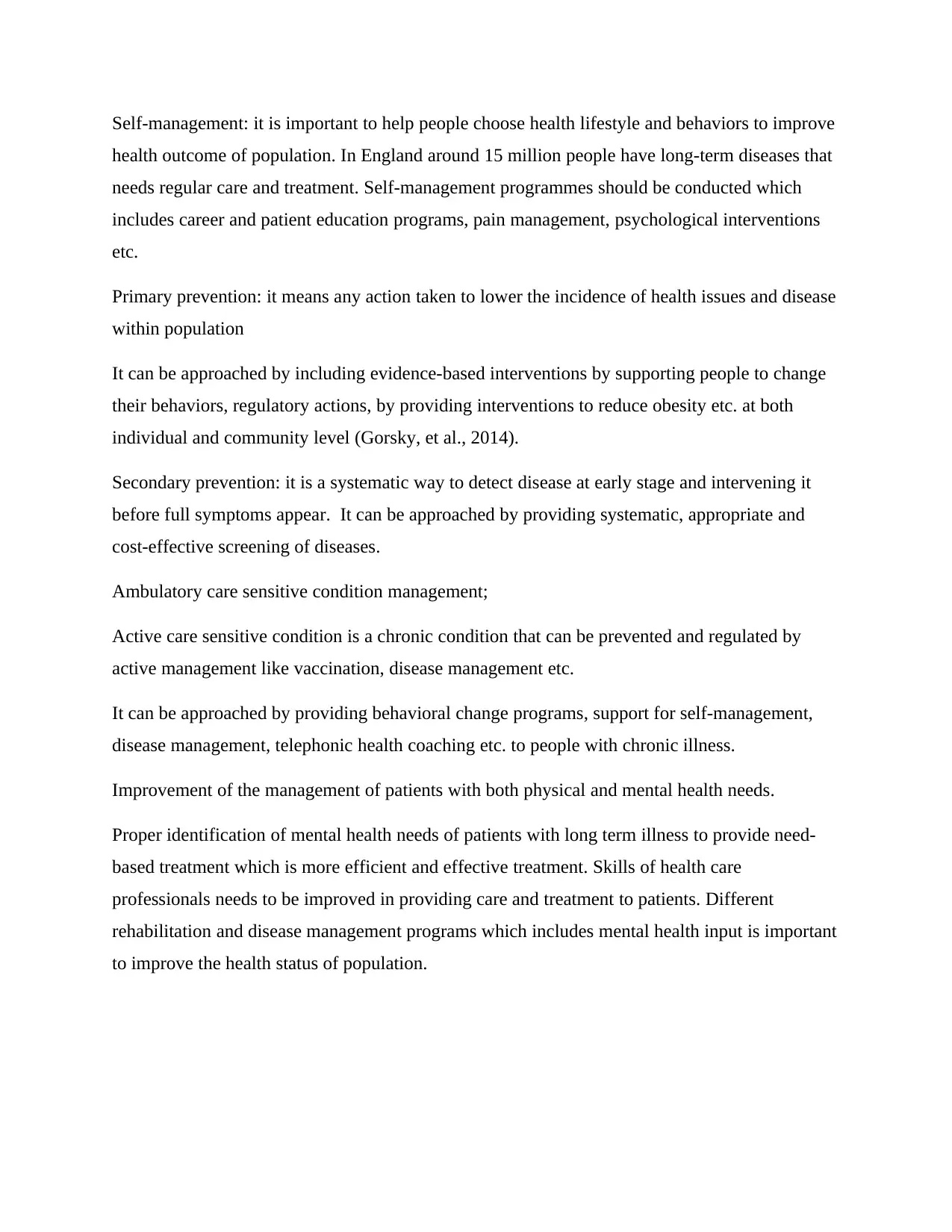
Self-management: it is important to help people choose health lifestyle and behaviors to improve
health outcome of population. In England around 15 million people have long-term diseases that
needs regular care and treatment. Self-management programmes should be conducted which
includes career and patient education programs, pain management, psychological interventions
etc.
Primary prevention: it means any action taken to lower the incidence of health issues and disease
within population
It can be approached by including evidence-based interventions by supporting people to change
their behaviors, regulatory actions, by providing interventions to reduce obesity etc. at both
individual and community level (Gorsky, et al., 2014).
Secondary prevention: it is a systematic way to detect disease at early stage and intervening it
before full symptoms appear. It can be approached by providing systematic, appropriate and
cost-effective screening of diseases.
Ambulatory care sensitive condition management;
Active care sensitive condition is a chronic condition that can be prevented and regulated by
active management like vaccination, disease management etc.
It can be approached by providing behavioral change programs, support for self-management,
disease management, telephonic health coaching etc. to people with chronic illness.
Improvement of the management of patients with both physical and mental health needs.
Proper identification of mental health needs of patients with long term illness to provide need-
based treatment which is more efficient and effective treatment. Skills of health care
professionals needs to be improved in providing care and treatment to patients. Different
rehabilitation and disease management programs which includes mental health input is important
to improve the health status of population.
health outcome of population. In England around 15 million people have long-term diseases that
needs regular care and treatment. Self-management programmes should be conducted which
includes career and patient education programs, pain management, psychological interventions
etc.
Primary prevention: it means any action taken to lower the incidence of health issues and disease
within population
It can be approached by including evidence-based interventions by supporting people to change
their behaviors, regulatory actions, by providing interventions to reduce obesity etc. at both
individual and community level (Gorsky, et al., 2014).
Secondary prevention: it is a systematic way to detect disease at early stage and intervening it
before full symptoms appear. It can be approached by providing systematic, appropriate and
cost-effective screening of diseases.
Ambulatory care sensitive condition management;
Active care sensitive condition is a chronic condition that can be prevented and regulated by
active management like vaccination, disease management etc.
It can be approached by providing behavioral change programs, support for self-management,
disease management, telephonic health coaching etc. to people with chronic illness.
Improvement of the management of patients with both physical and mental health needs.
Proper identification of mental health needs of patients with long term illness to provide need-
based treatment which is more efficient and effective treatment. Skills of health care
professionals needs to be improved in providing care and treatment to patients. Different
rehabilitation and disease management programs which includes mental health input is important
to improve the health status of population.
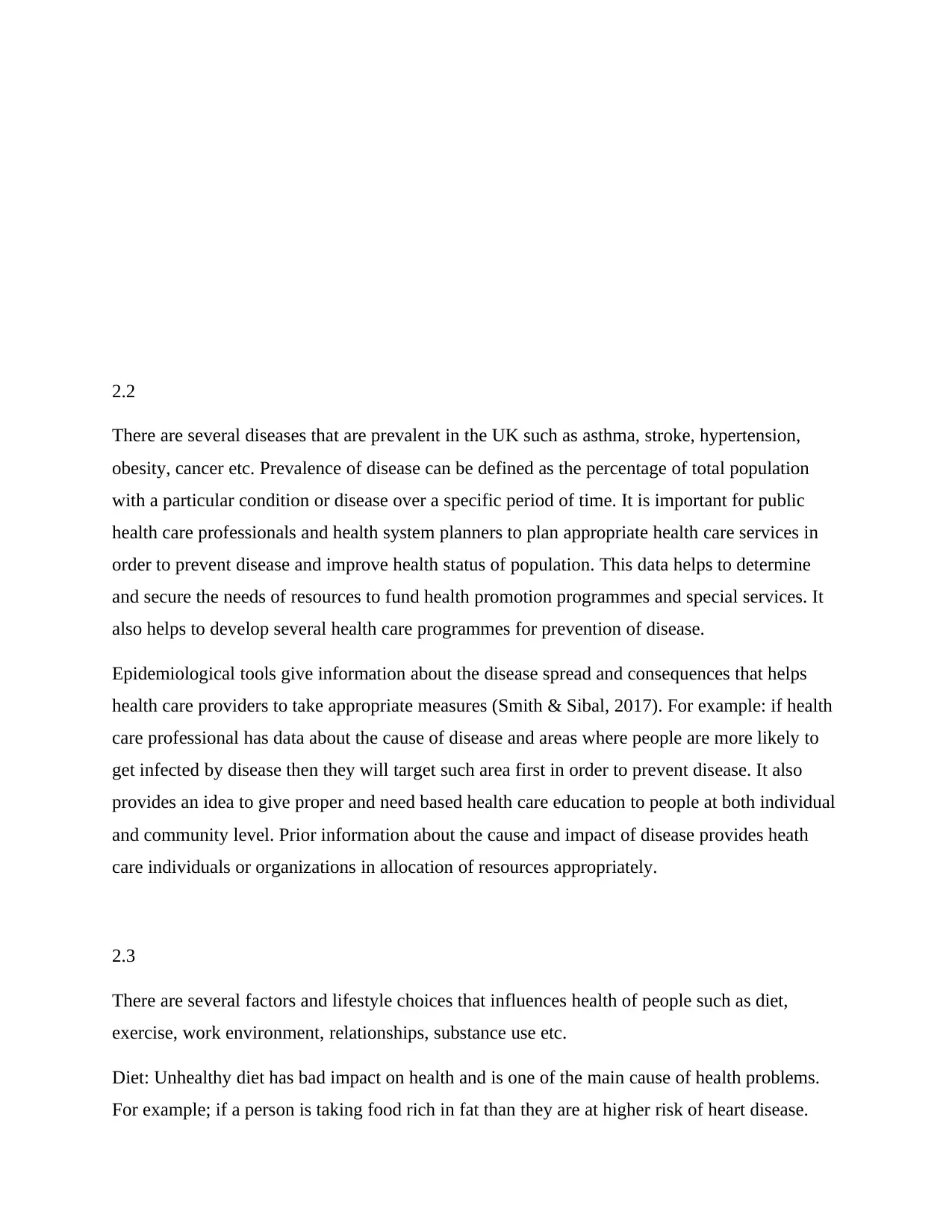
2.2
There are several diseases that are prevalent in the UK such as asthma, stroke, hypertension,
obesity, cancer etc. Prevalence of disease can be defined as the percentage of total population
with a particular condition or disease over a specific period of time. It is important for public
health care professionals and health system planners to plan appropriate health care services in
order to prevent disease and improve health status of population. This data helps to determine
and secure the needs of resources to fund health promotion programmes and special services. It
also helps to develop several health care programmes for prevention of disease.
Epidemiological tools give information about the disease spread and consequences that helps
health care providers to take appropriate measures (Smith & Sibal, 2017). For example: if health
care professional has data about the cause of disease and areas where people are more likely to
get infected by disease then they will target such area first in order to prevent disease. It also
provides an idea to give proper and need based health care education to people at both individual
and community level. Prior information about the cause and impact of disease provides heath
care individuals or organizations in allocation of resources appropriately.
2.3
There are several factors and lifestyle choices that influences health of people such as diet,
exercise, work environment, relationships, substance use etc.
Diet: Unhealthy diet has bad impact on health and is one of the main cause of health problems.
For example; if a person is taking food rich in fat than they are at higher risk of heart disease.
There are several diseases that are prevalent in the UK such as asthma, stroke, hypertension,
obesity, cancer etc. Prevalence of disease can be defined as the percentage of total population
with a particular condition or disease over a specific period of time. It is important for public
health care professionals and health system planners to plan appropriate health care services in
order to prevent disease and improve health status of population. This data helps to determine
and secure the needs of resources to fund health promotion programmes and special services. It
also helps to develop several health care programmes for prevention of disease.
Epidemiological tools give information about the disease spread and consequences that helps
health care providers to take appropriate measures (Smith & Sibal, 2017). For example: if health
care professional has data about the cause of disease and areas where people are more likely to
get infected by disease then they will target such area first in order to prevent disease. It also
provides an idea to give proper and need based health care education to people at both individual
and community level. Prior information about the cause and impact of disease provides heath
care individuals or organizations in allocation of resources appropriately.
2.3
There are several factors and lifestyle choices that influences health of people such as diet,
exercise, work environment, relationships, substance use etc.
Diet: Unhealthy diet has bad impact on health and is one of the main cause of health problems.
For example; if a person is taking food rich in fat than they are at higher risk of heart disease.
⊘ This is a preview!⊘
Do you want full access?
Subscribe today to unlock all pages.

Trusted by 1+ million students worldwide
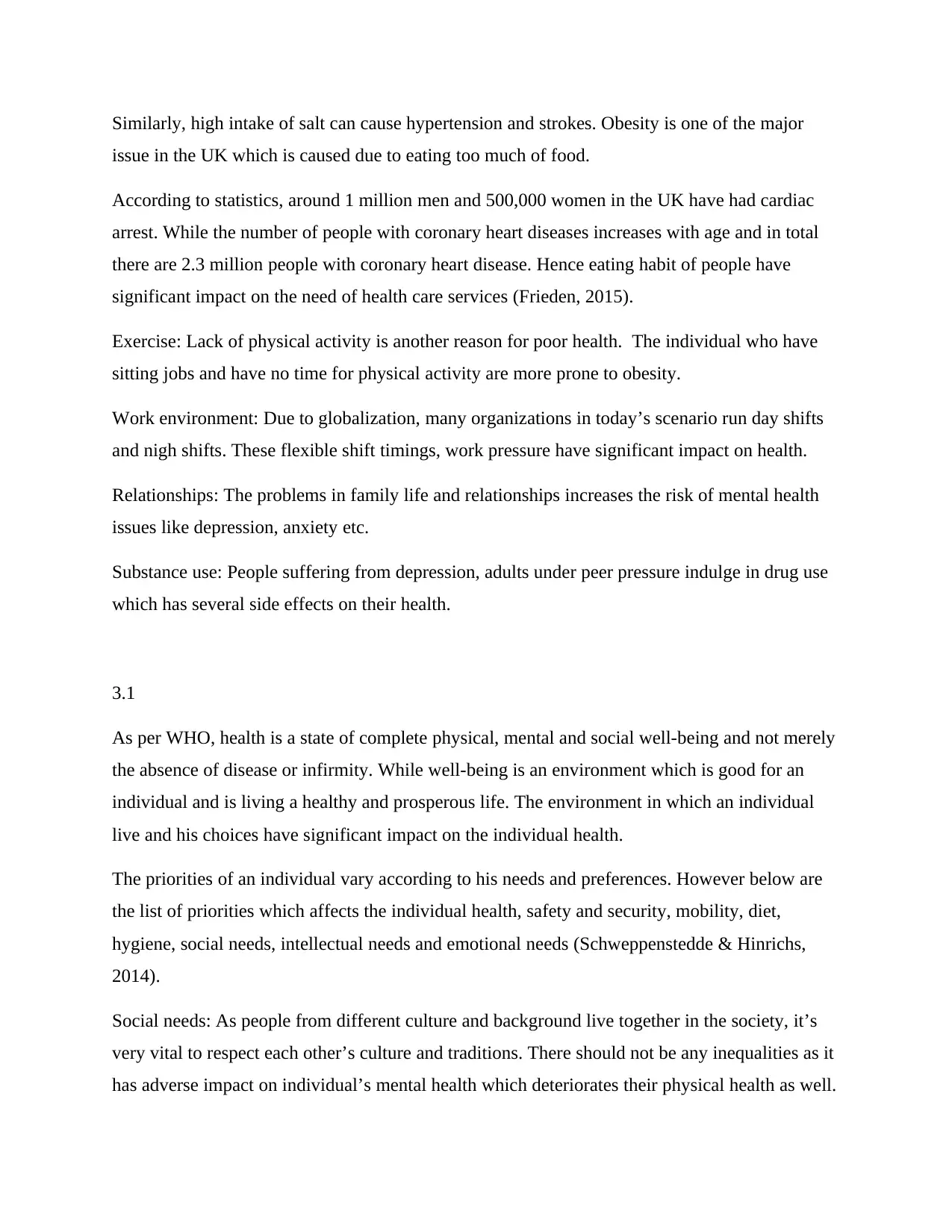
Similarly, high intake of salt can cause hypertension and strokes. Obesity is one of the major
issue in the UK which is caused due to eating too much of food.
According to statistics, around 1 million men and 500,000 women in the UK have had cardiac
arrest. While the number of people with coronary heart diseases increases with age and in total
there are 2.3 million people with coronary heart disease. Hence eating habit of people have
significant impact on the need of health care services (Frieden, 2015).
Exercise: Lack of physical activity is another reason for poor health. The individual who have
sitting jobs and have no time for physical activity are more prone to obesity.
Work environment: Due to globalization, many organizations in today’s scenario run day shifts
and nigh shifts. These flexible shift timings, work pressure have significant impact on health.
Relationships: The problems in family life and relationships increases the risk of mental health
issues like depression, anxiety etc.
Substance use: People suffering from depression, adults under peer pressure indulge in drug use
which has several side effects on their health.
3.1
As per WHO, health is a state of complete physical, mental and social well-being and not merely
the absence of disease or infirmity. While well-being is an environment which is good for an
individual and is living a healthy and prosperous life. The environment in which an individual
live and his choices have significant impact on the individual health.
The priorities of an individual vary according to his needs and preferences. However below are
the list of priorities which affects the individual health, safety and security, mobility, diet,
hygiene, social needs, intellectual needs and emotional needs (Schweppenstedde & Hinrichs,
2014).
Social needs: As people from different culture and background live together in the society, it’s
very vital to respect each other’s culture and traditions. There should not be any inequalities as it
has adverse impact on individual’s mental health which deteriorates their physical health as well.
issue in the UK which is caused due to eating too much of food.
According to statistics, around 1 million men and 500,000 women in the UK have had cardiac
arrest. While the number of people with coronary heart diseases increases with age and in total
there are 2.3 million people with coronary heart disease. Hence eating habit of people have
significant impact on the need of health care services (Frieden, 2015).
Exercise: Lack of physical activity is another reason for poor health. The individual who have
sitting jobs and have no time for physical activity are more prone to obesity.
Work environment: Due to globalization, many organizations in today’s scenario run day shifts
and nigh shifts. These flexible shift timings, work pressure have significant impact on health.
Relationships: The problems in family life and relationships increases the risk of mental health
issues like depression, anxiety etc.
Substance use: People suffering from depression, adults under peer pressure indulge in drug use
which has several side effects on their health.
3.1
As per WHO, health is a state of complete physical, mental and social well-being and not merely
the absence of disease or infirmity. While well-being is an environment which is good for an
individual and is living a healthy and prosperous life. The environment in which an individual
live and his choices have significant impact on the individual health.
The priorities of an individual vary according to his needs and preferences. However below are
the list of priorities which affects the individual health, safety and security, mobility, diet,
hygiene, social needs, intellectual needs and emotional needs (Schweppenstedde & Hinrichs,
2014).
Social needs: As people from different culture and background live together in the society, it’s
very vital to respect each other’s culture and traditions. There should not be any inequalities as it
has adverse impact on individual’s mental health which deteriorates their physical health as well.
Paraphrase This Document
Need a fresh take? Get an instant paraphrase of this document with our AI Paraphraser
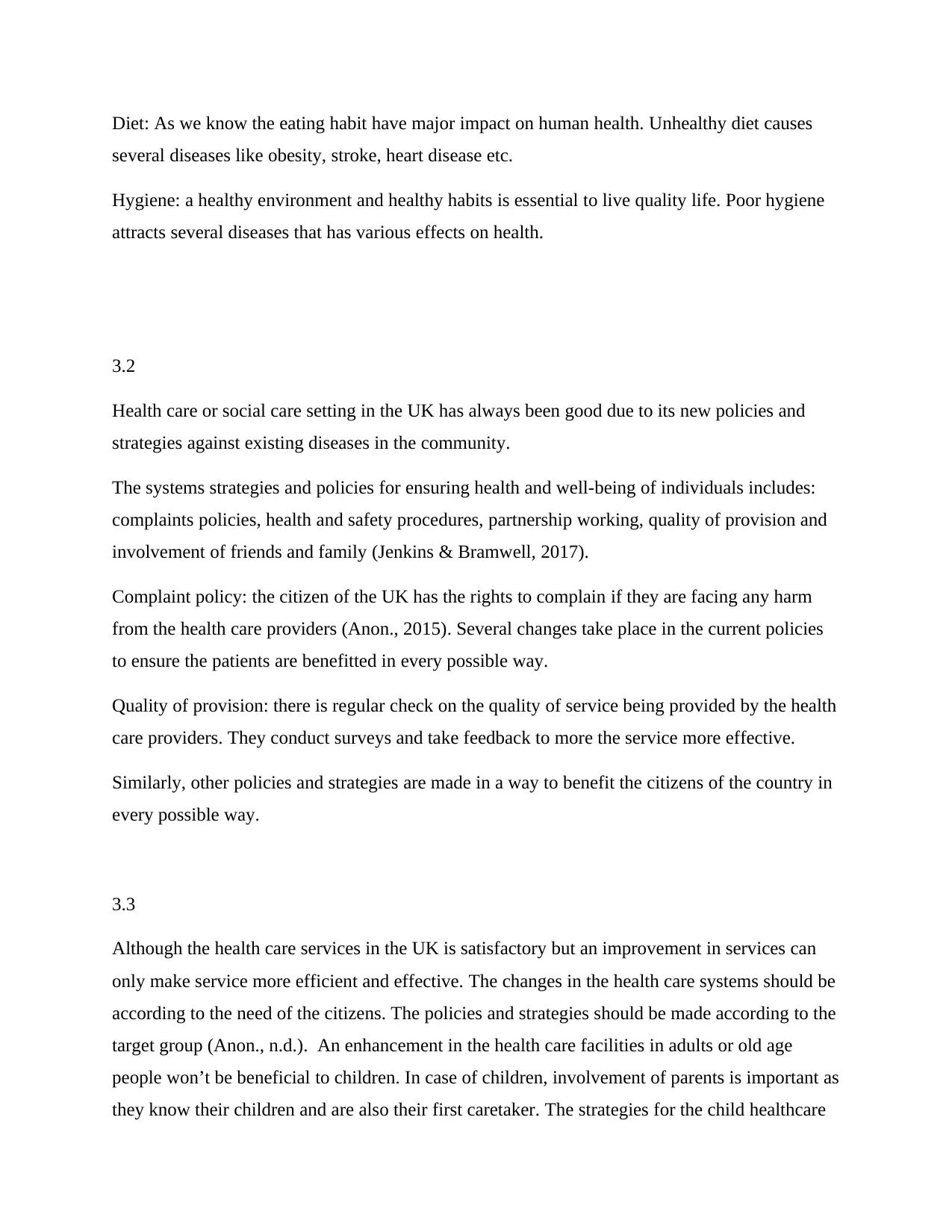
Diet: As we know the eating habit have major impact on human health. Unhealthy diet causes
several diseases like obesity, stroke, heart disease etc.
Hygiene: a healthy environment and healthy habits is essential to live quality life. Poor hygiene
attracts several diseases that has various effects on health.
3.2
Health care or social care setting in the UK has always been good due to its new policies and
strategies against existing diseases in the community.
The systems strategies and policies for ensuring health and well-being of individuals includes:
complaints policies, health and safety procedures, partnership working, quality of provision and
involvement of friends and family (Jenkins & Bramwell, 2017).
Complaint policy: the citizen of the UK has the rights to complain if they are facing any harm
from the health care providers (Anon., 2015). Several changes take place in the current policies
to ensure the patients are benefitted in every possible way.
Quality of provision: there is regular check on the quality of service being provided by the health
care providers. They conduct surveys and take feedback to more the service more effective.
Similarly, other policies and strategies are made in a way to benefit the citizens of the country in
every possible way.
3.3
Although the health care services in the UK is satisfactory but an improvement in services can
only make service more efficient and effective. The changes in the health care systems should be
according to the need of the citizens. The policies and strategies should be made according to the
target group (Anon., n.d.). An enhancement in the health care facilities in adults or old age
people won’t be beneficial to children. In case of children, involvement of parents is important as
they know their children and are also their first caretaker. The strategies for the child healthcare
several diseases like obesity, stroke, heart disease etc.
Hygiene: a healthy environment and healthy habits is essential to live quality life. Poor hygiene
attracts several diseases that has various effects on health.
3.2
Health care or social care setting in the UK has always been good due to its new policies and
strategies against existing diseases in the community.
The systems strategies and policies for ensuring health and well-being of individuals includes:
complaints policies, health and safety procedures, partnership working, quality of provision and
involvement of friends and family (Jenkins & Bramwell, 2017).
Complaint policy: the citizen of the UK has the rights to complain if they are facing any harm
from the health care providers (Anon., 2015). Several changes take place in the current policies
to ensure the patients are benefitted in every possible way.
Quality of provision: there is regular check on the quality of service being provided by the health
care providers. They conduct surveys and take feedback to more the service more effective.
Similarly, other policies and strategies are made in a way to benefit the citizens of the country in
every possible way.
3.3
Although the health care services in the UK is satisfactory but an improvement in services can
only make service more efficient and effective. The changes in the health care systems should be
according to the need of the citizens. The policies and strategies should be made according to the
target group (Anon., n.d.). An enhancement in the health care facilities in adults or old age
people won’t be beneficial to children. In case of children, involvement of parents is important as
they know their children and are also their first caretaker. The strategies for the child healthcare
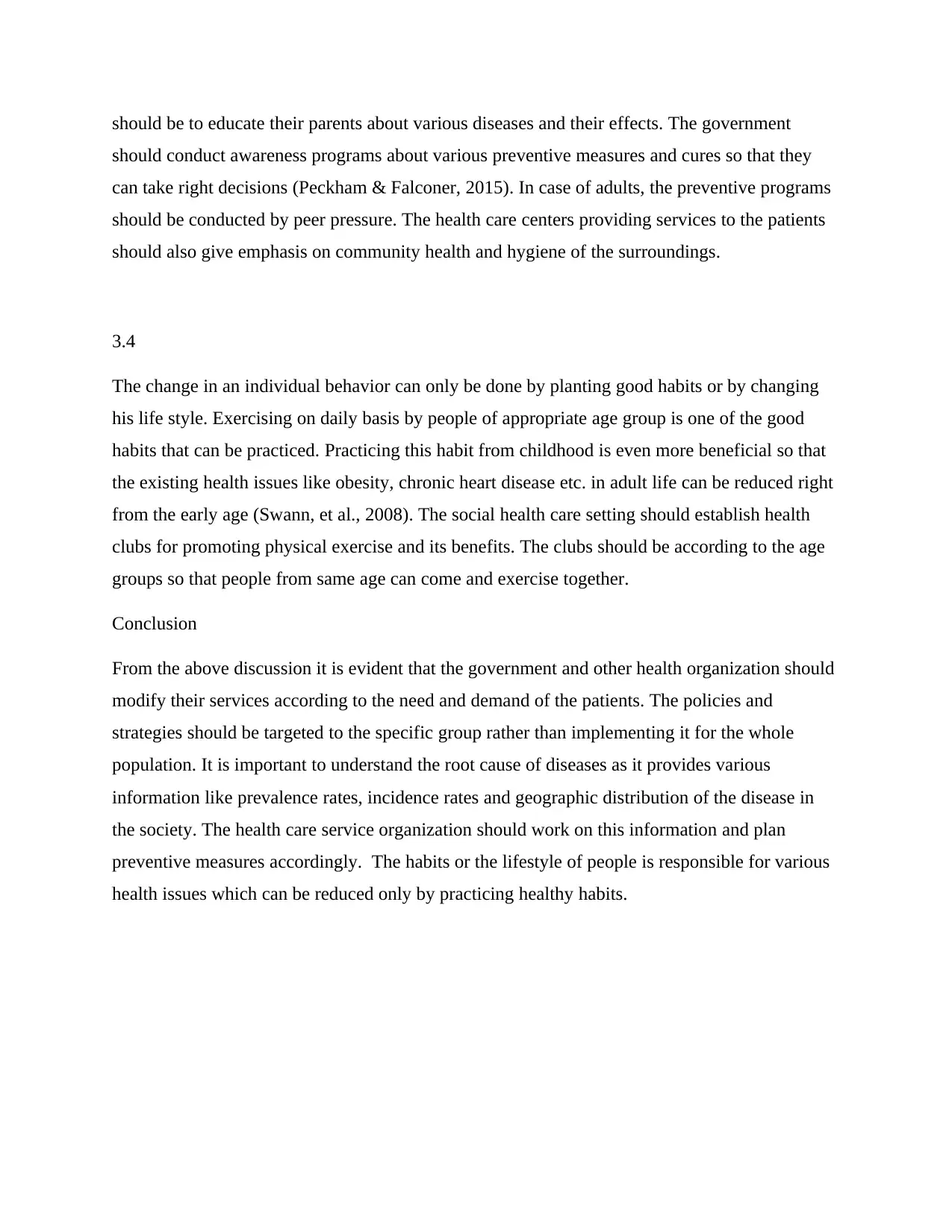
should be to educate their parents about various diseases and their effects. The government
should conduct awareness programs about various preventive measures and cures so that they
can take right decisions (Peckham & Falconer, 2015). In case of adults, the preventive programs
should be conducted by peer pressure. The health care centers providing services to the patients
should also give emphasis on community health and hygiene of the surroundings.
3.4
The change in an individual behavior can only be done by planting good habits or by changing
his life style. Exercising on daily basis by people of appropriate age group is one of the good
habits that can be practiced. Practicing this habit from childhood is even more beneficial so that
the existing health issues like obesity, chronic heart disease etc. in adult life can be reduced right
from the early age (Swann, et al., 2008). The social health care setting should establish health
clubs for promoting physical exercise and its benefits. The clubs should be according to the age
groups so that people from same age can come and exercise together.
Conclusion
From the above discussion it is evident that the government and other health organization should
modify their services according to the need and demand of the patients. The policies and
strategies should be targeted to the specific group rather than implementing it for the whole
population. It is important to understand the root cause of diseases as it provides various
information like prevalence rates, incidence rates and geographic distribution of the disease in
the society. The health care service organization should work on this information and plan
preventive measures accordingly. The habits or the lifestyle of people is responsible for various
health issues which can be reduced only by practicing healthy habits.
should conduct awareness programs about various preventive measures and cures so that they
can take right decisions (Peckham & Falconer, 2015). In case of adults, the preventive programs
should be conducted by peer pressure. The health care centers providing services to the patients
should also give emphasis on community health and hygiene of the surroundings.
3.4
The change in an individual behavior can only be done by planting good habits or by changing
his life style. Exercising on daily basis by people of appropriate age group is one of the good
habits that can be practiced. Practicing this habit from childhood is even more beneficial so that
the existing health issues like obesity, chronic heart disease etc. in adult life can be reduced right
from the early age (Swann, et al., 2008). The social health care setting should establish health
clubs for promoting physical exercise and its benefits. The clubs should be according to the age
groups so that people from same age can come and exercise together.
Conclusion
From the above discussion it is evident that the government and other health organization should
modify their services according to the need and demand of the patients. The policies and
strategies should be targeted to the specific group rather than implementing it for the whole
population. It is important to understand the root cause of diseases as it provides various
information like prevalence rates, incidence rates and geographic distribution of the disease in
the society. The health care service organization should work on this information and plan
preventive measures accordingly. The habits or the lifestyle of people is responsible for various
health issues which can be reduced only by practicing healthy habits.
⊘ This is a preview!⊘
Do you want full access?
Subscribe today to unlock all pages.

Trusted by 1+ million students worldwide
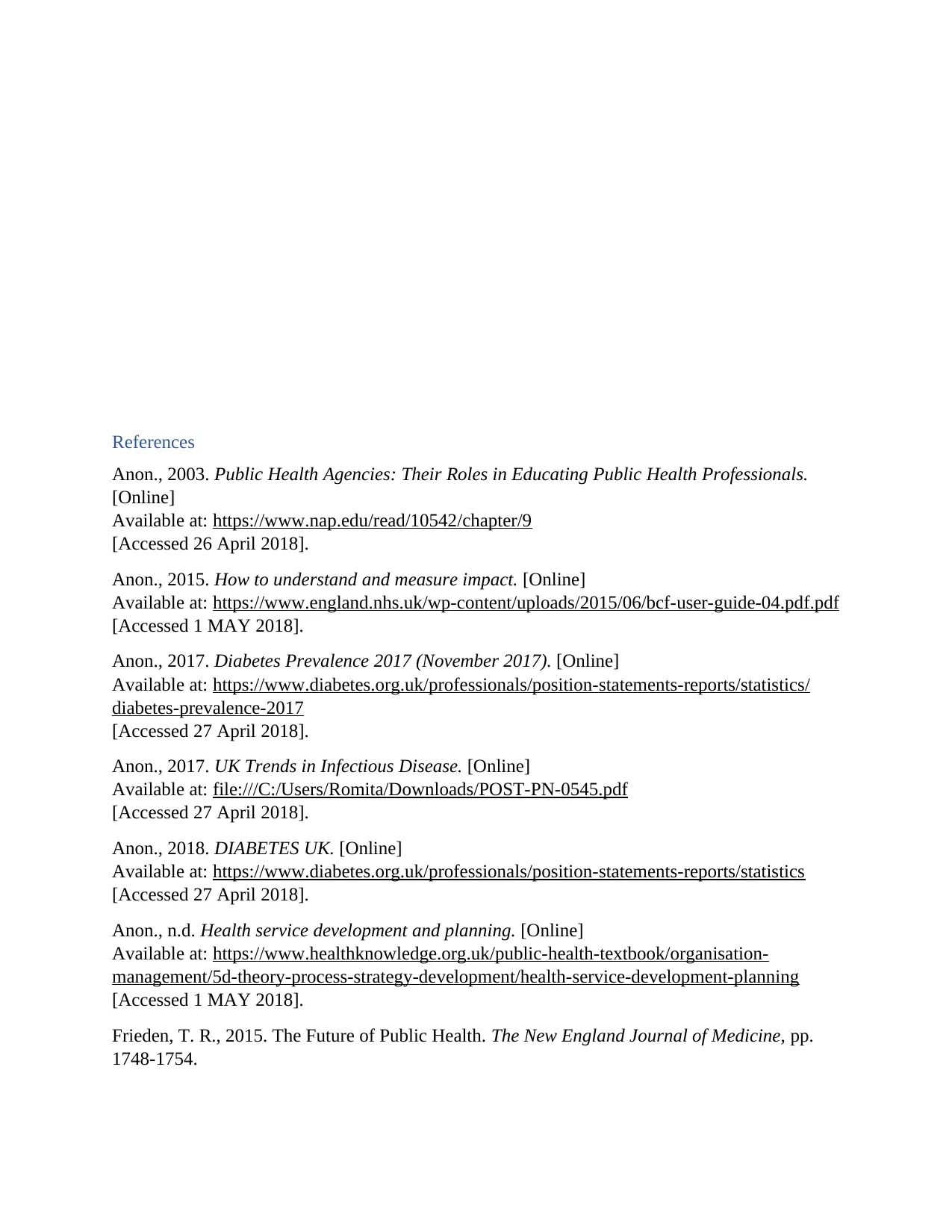
References
Anon., 2003. Public Health Agencies: Their Roles in Educating Public Health Professionals.
[Online]
Available at: https://www.nap.edu/read/10542/chapter/9
[Accessed 26 April 2018].
Anon., 2015. How to understand and measure impact. [Online]
Available at: https://www.england.nhs.uk/wp-content/uploads/2015/06/bcf-user-guide-04.pdf.pdf
[Accessed 1 MAY 2018].
Anon., 2017. Diabetes Prevalence 2017 (November 2017). [Online]
Available at: https://www.diabetes.org.uk/professionals/position-statements-reports/statistics/
diabetes-prevalence-2017
[Accessed 27 April 2018].
Anon., 2017. UK Trends in Infectious Disease. [Online]
Available at: file:///C:/Users/Romita/Downloads/POST-PN-0545.pdf
[Accessed 27 April 2018].
Anon., 2018. DIABETES UK. [Online]
Available at: https://www.diabetes.org.uk/professionals/position-statements-reports/statistics
[Accessed 27 April 2018].
Anon., n.d. Health service development and planning. [Online]
Available at: https://www.healthknowledge.org.uk/public-health-textbook/organisation-
management/5d-theory-process-strategy-development/health-service-development-planning
[Accessed 1 MAY 2018].
Frieden, T. R., 2015. The Future of Public Health. The New England Journal of Medicine, pp.
1748-1754.
Anon., 2003. Public Health Agencies: Their Roles in Educating Public Health Professionals.
[Online]
Available at: https://www.nap.edu/read/10542/chapter/9
[Accessed 26 April 2018].
Anon., 2015. How to understand and measure impact. [Online]
Available at: https://www.england.nhs.uk/wp-content/uploads/2015/06/bcf-user-guide-04.pdf.pdf
[Accessed 1 MAY 2018].
Anon., 2017. Diabetes Prevalence 2017 (November 2017). [Online]
Available at: https://www.diabetes.org.uk/professionals/position-statements-reports/statistics/
diabetes-prevalence-2017
[Accessed 27 April 2018].
Anon., 2017. UK Trends in Infectious Disease. [Online]
Available at: file:///C:/Users/Romita/Downloads/POST-PN-0545.pdf
[Accessed 27 April 2018].
Anon., 2018. DIABETES UK. [Online]
Available at: https://www.diabetes.org.uk/professionals/position-statements-reports/statistics
[Accessed 27 April 2018].
Anon., n.d. Health service development and planning. [Online]
Available at: https://www.healthknowledge.org.uk/public-health-textbook/organisation-
management/5d-theory-process-strategy-development/health-service-development-planning
[Accessed 1 MAY 2018].
Frieden, T. R., 2015. The Future of Public Health. The New England Journal of Medicine, pp.
1748-1754.
Paraphrase This Document
Need a fresh take? Get an instant paraphrase of this document with our AI Paraphraser
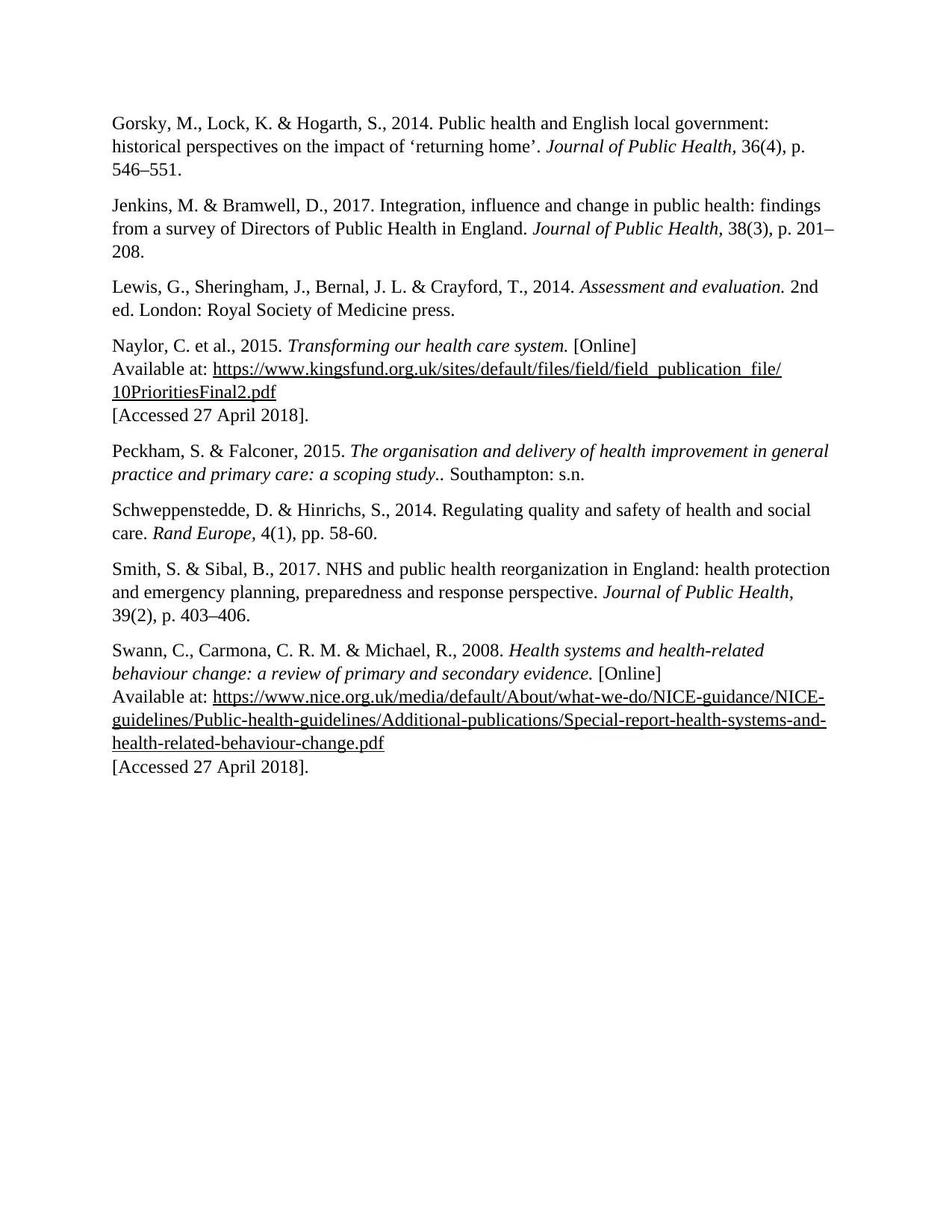
Gorsky, M., Lock, K. & Hogarth, S., 2014. Public health and English local government:
historical perspectives on the impact of ‘returning home’. Journal of Public Health, 36(4), p.
546–551.
Jenkins, M. & Bramwell, D., 2017. Integration, influence and change in public health: findings
from a survey of Directors of Public Health in England. Journal of Public Health, 38(3), p. 201–
208.
Lewis, G., Sheringham, J., Bernal, J. L. & Crayford, T., 2014. Assessment and evaluation. 2nd
ed. London: Royal Society of Medicine press.
Naylor, C. et al., 2015. Transforming our health care system. [Online]
Available at: https://www.kingsfund.org.uk/sites/default/files/field/field_publication_file/
10PrioritiesFinal2.pdf
[Accessed 27 April 2018].
Peckham, S. & Falconer, 2015. The organisation and delivery of health improvement in general
practice and primary care: a scoping study.. Southampton: s.n.
Schweppenstedde, D. & Hinrichs, S., 2014. Regulating quality and safety of health and social
care. Rand Europe, 4(1), pp. 58-60.
Smith, S. & Sibal, B., 2017. NHS and public health reorganization in England: health protection
and emergency planning, preparedness and response perspective. Journal of Public Health,
39(2), p. 403–406.
Swann, C., Carmona, C. R. M. & Michael, R., 2008. Health systems and health-related
behaviour change: a review of primary and secondary evidence. [Online]
Available at: https://www.nice.org.uk/media/default/About/what-we-do/NICE-guidance/NICE-
guidelines/Public-health-guidelines/Additional-publications/Special-report-health-systems-and-
health-related-behaviour-change.pdf
[Accessed 27 April 2018].
historical perspectives on the impact of ‘returning home’. Journal of Public Health, 36(4), p.
546–551.
Jenkins, M. & Bramwell, D., 2017. Integration, influence and change in public health: findings
from a survey of Directors of Public Health in England. Journal of Public Health, 38(3), p. 201–
208.
Lewis, G., Sheringham, J., Bernal, J. L. & Crayford, T., 2014. Assessment and evaluation. 2nd
ed. London: Royal Society of Medicine press.
Naylor, C. et al., 2015. Transforming our health care system. [Online]
Available at: https://www.kingsfund.org.uk/sites/default/files/field/field_publication_file/
10PrioritiesFinal2.pdf
[Accessed 27 April 2018].
Peckham, S. & Falconer, 2015. The organisation and delivery of health improvement in general
practice and primary care: a scoping study.. Southampton: s.n.
Schweppenstedde, D. & Hinrichs, S., 2014. Regulating quality and safety of health and social
care. Rand Europe, 4(1), pp. 58-60.
Smith, S. & Sibal, B., 2017. NHS and public health reorganization in England: health protection
and emergency planning, preparedness and response perspective. Journal of Public Health,
39(2), p. 403–406.
Swann, C., Carmona, C. R. M. & Michael, R., 2008. Health systems and health-related
behaviour change: a review of primary and secondary evidence. [Online]
Available at: https://www.nice.org.uk/media/default/About/what-we-do/NICE-guidance/NICE-
guidelines/Public-health-guidelines/Additional-publications/Special-report-health-systems-and-
health-related-behaviour-change.pdf
[Accessed 27 April 2018].
1 out of 11
Related Documents
Your All-in-One AI-Powered Toolkit for Academic Success.
+13062052269
info@desklib.com
Available 24*7 on WhatsApp / Email
![[object Object]](/_next/static/media/star-bottom.7253800d.svg)
Unlock your academic potential
Copyright © 2020–2025 A2Z Services. All Rights Reserved. Developed and managed by ZUCOL.





